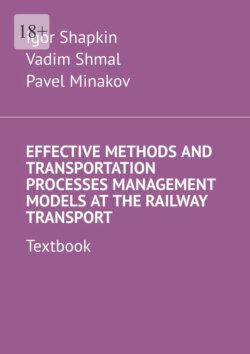Читать книгу Effective Methods and Transportation Processes Management Models at the Railway Transport. Textbook - Vadim Shmal - Страница 3
1 INFORMATIZATION AS A STRATEGIC COURSE FOR THE RAILWAY TRANSPORT RESTRUCTURING
ОглавлениеInformatization of transport is an integral part of the society informatization national process associated with the production and widespread use of information as a special type of resource based on the transition to high-tech and knowledge-intensive methods of organizing transportation.
Informatization is based on the Concept and Program of Informatization of Railway Transport, which is a system of goals, objectives and main directions of informatization for a given period, priorities, means and ways to achieve the goals of informatization.
Information environment – information implemented in a databases and knowledge system, which ensures the functioning of objects, controls and individual users associated with transport. The ultimate goal of designing an information environment is to create a single transparent information space in which all interested users can be provided with the necessary and reliable information everywhere at the right time and in a convenient form.
The transport informatization infrastructure is designed to provide living conditions for the information environment and, first of all, its physical support and maintenance.
The second level of informatization representation is determined by its applied or user role, achieved by the formation of new information technologies.
New information technologies are a systemic concept that combines new high-tech and knowledge-intensive models and methods of transport management into a single whole, and provide the level of informatization represented by the information environment and infrastructure.
The changes in the methods of automated control of technological processes accumulated in recent years in railway transport, the priorities of the goals of functioning require new modern solutions aimed at reducing costs and increasing industry revenues.
In the context of the transition to a market economy, it is impossible to ensure the operation of railway transport without the use of new technologies, which, as world experience shows, are the most important means for the formation of a competitive, sustainable production and economic model of the transport system.
The introduction of new effective technologies that provide «breakthrough» directions of informatization is hampered by the lack of adequate scientifically based models and methods for solving the problems of railway transport management in the current and future periods of the industry’s functioning.
It is possible to develop new information technologies using the SADT methodology for describing complex systems and industries.
The most important product of designing new information technologies is mathematical models that allow you to understand the structure of the future system, balance requirements and build an effective management system.
The construction of mathematical models occupies a leading place among the problems of creating new methods, their development and management.
The infiltration of new management methods into railway transport follows the path of mathematical modeling of the corresponding objects. If an adequate model of the management system is built, then its study will make it possible to identify the bottlenecks and imperfections of the existing system, develop alternative options for its development and evaluate their effectiveness in terms of achieving the goals of the system and solving its main tasks. Currently, there are a large number of works by authors devoted to the problem of constructing mathematical models for managing transport systems and production. In these works, modeling works in any local area are usually considered using specific methodological tools of mathematical modeling.
This is due to the fact that there is no urgent need to build, coordinate and update integrated management models, since the local ones coped with their tasks quite well. Local modeling, as a rule, is based on any one type of model, which makes it possible to standardize the language for describing models and methods for their analysis
However, local modeling methods are not productive enough to describe large-scale enterprise systems such as rail transport.
The expressive capabilities of any particular variety of models are limited, making it adequate only for a limited field of application. The poor scalability of the developed models does not allow to flexibly and adequately describe the variety of aspects of the activities of systems, both small and large-scale.
The study methodological basis is based on a systemological approach. The development of a comprehensive modeling methodology is based on an architectural concept, frame theory and a variety of complementary types of models and methods.
A systemological approach to the development of large-scale software areas should meet the following basic conceptual requirements:
• ensure the design and development of new information technologies in strict accordance with the requirements for the management system;
• to form an adequate system of models that are functionally interconnected and coordinated in strict accordance with the goals of management systems;
• allow continuous research and improvement of information technologies based on systems and models;
• ensure the transition to new information technologies based on digital models and computing systems.
Modern computer technologies should provide new methodological capabilities, be considered through specific information technologies and the tools that support them; use a set of methodological tools that automate the basic processes of designing system solutions; ensure the construction of a single constantly evolving knowledge base, which should contain all the information about the model system; have formalized rules for the transition from analysis to design and vice versa; be visual and easy to learn.
Systemological paradigms represent the most significant attributes for further research purposes, the fundamental essence of the «systemological approach» under consideration.
«There is no branch of mathematics, even the most abstract, that cannot ever be applied to the real world.»
N.I. Lobachevsky
